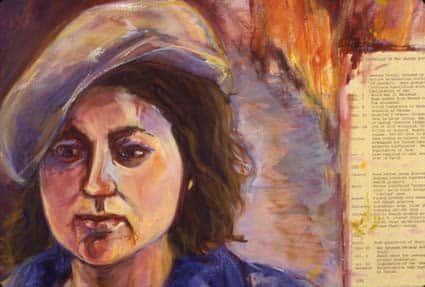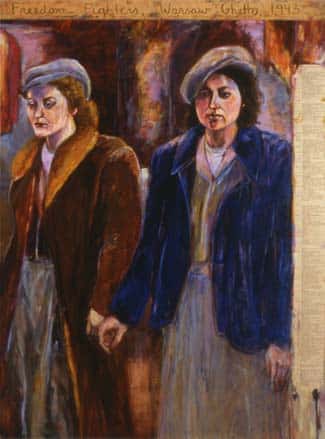by Cynthia L Cooper
Almost as soon as I entered the German Memorial Resistance Center in Berlin, I regretted having saved it as the last stop on my short trip. Of course,it had been difficult to tell from afar in New York what I would find here. The “center” could have been a single room, or single stack of books and articles. The tourist bureau didn’t have it listed, and the proprietor of my small hotel explicitly told me I wouldn’t want to visit, and, thrusting literature into my hand, recommended a boat tour through the city instead.
But I wasn’t in Berlin for the boat ride. I was conducting research. My interest had to do with a play that I was writing about a Jewish woman and Catholic man – Gisa Peiper and Paul Konopka — who had joined together to fight the rise of the Nazis in the early 1930s. Based on a real story, both eventually escaped and resettled in the United States, but not without lasting scars.

By the time I arrived in Germany in August 2007, I had already written several scenes for the play and had a title, too: Silence Not, A Love Story. But I had many questions about the nature of resistance and the tenor of the times in Germany before Hitler took power.
Daring to Speak Out
I had become captivated by Gisa and her unwavering commitment to human rights. Taking the name of Konopka after she and Paul married, she became an influential professor at the University of Minnesota, specializing in programs to help troubled youth. She insisted that all persons have the capacity for destruction and for great love and giving. Before her death in 2003, she wrote, “It will depend on us, each person within each generation at all times, what we help to bring forth. This is an unending task.”
Both Gisa and Paul were members of the ISK, or the International Socialist Combat League, which, despite its name, was a group of pacifists that first came together after World War I. Involved in labor activism, they were passionate about art, the outdoors and justice. Gisa moved to the labor town of Hamburg in 1929 at age 19, and it was there that she met Paul, a craftsman who was a few years her senior.
Led at that time by Willie Eichler and Minna Specht, the ISK had chapters in several German cities. As the economic crisis heated up in the early 1930s and right-wing rhetoric began to take sway, the ISK moved to anti-Nazi activism. Already Nazi goons were beating up people on the streets and attacking any who stood in their way. ISK members created newsletters and delivered them door-to-door to alert the public about the dangerous ideology of Hitler and his National Socialists.
Why had they been so determined to speak out? Why had not others?
| Mostly, they were ordinary – people who seemed unexceptional |
Gisa had insisted that the anti-Nazi movement in Germany was underestimated. She wrote: “There was resistance against the Nazis inside Germany consisting of a variety of people who had a conscience and courage. Those people included Jews (who are unjustly accused of never having resisted), women (who are practically omitted in the history of resistance), and non-Jewish Germans, as well as many of the old labor movements (who also are hardly mentioned). They fought the Nazis out of basically moral convictions and out of abhorrence of racial superiority.”
I hoped to find out at this center in Berlin if her perception was accurate. After trekking with luggage through the crowded Berlin art district, lost, my traveling partner and I found a cab. The driver said he knew where to find The Benderblock, the location of the resistance center, but even when he pulled up to the supposed address, I wasn’t convinced. The outside was an ugly government office building, looking the way that bureaucracies worldwide seem to look. The entrance was reached through the courtyard, which had an eerie haunted air with a statue of a man, wrists tied in front of him, representing the military officer executed here for an unsuccessful attempt on Hitler’s life. In front of the bronze figure, text said: “You could not endure the shame, you resisted.”
On an upper floor of the building was the “resistance center.”
Walls That Tell Hidden Stories
Suddenly, the dull and barren space opened into 26 rooms, one after another, running across an entire floor of the former Nazi defense department, and each displaying posters, photos and artifacts from people inside Germany who had resisted the Nazis. There were thousands of pictures of individuals, families, clubs and associations – men and women, seated at dinner or in front of typewriters or outside tents – all of whom were engaged in Nazi resistance. They were Catholic, Jewish, Lutheran, Quaker, Sinti and Roma; they were young and defiant, older and determined. Mostly, they were ordinary, I thought; people who bought rolls at the local bakery, people who seemed unexceptional.

I was particularly interested in the women. With little time to browse, I sped from room to room, trying to interpret the German on the placards. I recognized some of the resisters whose stories had become more famous. There was Sophie Scholl, a college student who, ten years after Gisa and Paul had engaged in resistance campaigns, founded The White Rose.
During a time when the Nazis ruled with iron fists, the group distributed literature calling the National Socialists “gangsters.” Their activities drew particular attention in 1943 after they issued a fiery response to a Nazi speaker at the University of Munich who had called upon women to end their studies and work in munitions plants or have babies. Scholl, arrested for treason and tried in a summary “People’s Court,” interrupted Roland Freisler, Hitler’s brutal “hanging” judge. “What we said and wrote are what many people are thinking,” she said. “They just don’t dare say it aloud.” Later that day, she was executed by guillotine.
There was homage to Kathe Kollwitz,whose verbal and visual protestations against fascism and efforts to organize artists to oppose Nazism meant that she was stripped of her university position within two weeks of Hitler’s ascension to power on January 30, 1933. I had already visited the Kathe Kollwitz Museum in Berlin (after all, how many museums in the world are devoted to a woman artist?), something that even met the approval of the hotel proprietor.
I found the stories of Mildred Harnack, Liane Berkowitz, Hilde Coppi, Elisabeth Schumaher, Maria Terwiel and Greeta Kuckoff, all members of The Red Orchestra, a loose affiliation of people in Germany who compiled documentation on Nazi crimes of violence, circulated handbills and provided underground assistance. They worked for years until they were discovered in 1942. Fifty Red Orchestra members were executed.
| 15,000 Germans were executed by the Nazis for “political crimes” |
There was the story of the Kreisau Circle, Germans of well-to-do backgrounds, who plotted against Hitler. Freya von Moltke, who died at age 98 on January 1, 2010, joined with her husband, Count Helmuth James von Moltke, to oppose the Nazis and preserve documentation of their efforts. There were names that were completely unfamiliar, like Liselotte Hermann, who was described as a participant in Communist resistance efforts, publicly protesting against Hitler’s government takeover. She was the mother of a two-year-old when she was executed in 1938.
Actual replicas of newsletters opposing the Nazis were on display with all of their awkward mimeography and cheap printing. I couldn’t read the language, but I understood the intent. But where was the newsletter of the ISK? I wondered.
One poster in English simply said: “Boycott Germany.” Walking down a long hallway, lined with photos of people who had resisted, I made a mental note: Put me on this wall, I thought.
Crimes Against Humanity
Authors Annette Dumbach and Jud Newborn estimate that 15,000 Germans were executed for political “crimes.” But, I concluded, there may be more resisters, hidden from history.
In Hamburg, I had visited the Fuhlsbuttel prison, where a plaque honored the several dozen political prisoners who had been executed at that site. This is where Gisa had been held in a solitary cell in 1936 until – inexplicably, but possibly to follow her – she was released. At the Gestapo-run prison, she heard the screams of neighbors and wondered what “acts of courage” they had committed. Occasionally, she had glimpses. One man, locked in the torture device of a standing coffin, started screaming, “Yes, I did listen to French radio.” A young woman, a Jehovah’s Witness who was forced to carry water buckets with two broken hands, had refused, on religious grounds, to take a Nazi oath.
| There may be more resisters, hidden from history |
Right before I had to leave the resistance center for the airport, I found a room dedicated to “Resistance from the Labor Movement Up to 1939.” Here, at last, I found a reference to the ISK and saw a picture of Minna Specht – standing outside, she seems extraordinarily attractive, although she looks as if she is downplaying it, along with the German notion of “order,” since strands of her hair are flying in every direction.
There was a drawer with an index of names in this room, too, and I scrolled through it quickly, looking for Gisa. She was not listed. There was no mention of Paul, either. Although I was momentarily disappointed, the feeling didn’t last long. Just as Gisa had said, there are other people, people not known even to this resistance center, who had resisted; if resistance were possible then, certainly it is possible when oppression arises in our own time.
And I already had Gisa’s story: tapes from The Shoah Project, the panel about her displayed at a museum in New York, the memories of friends. “Justice demands action,” Gisa would say. Dr. Marilyn Frost said that Gisa would gather groups of people in her home to talk about issues of the day, even after she retired. “Gisa always ended by reminding her visitors: ‘Talk is not enough, we must now DO something,’” said Frost.
As Nazi-resister Dietrich Bonhoeffer wrote before his execution in 1945,
Not in the flight of thought
But in the act alone is there freedom.
Cynthia L. Cooper is a journalist and playwright in New York. “Silence Not, A Love Story” is published by Gihon River Press.
Also see With the Understanding of Gandhi, Aminatou Put Her Life on the Line by Barbara Becker in this edition of On The Issues Magazine
See The Poet’s Eye in this edition of On The Issues Magazine
Visit The Café of On The Issues Magazine for new stories and updates.
